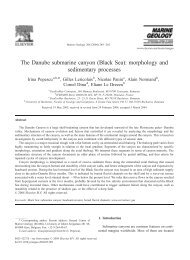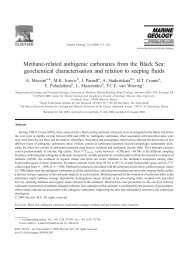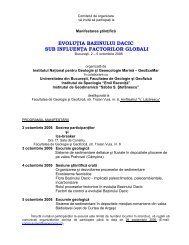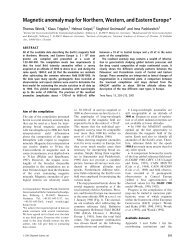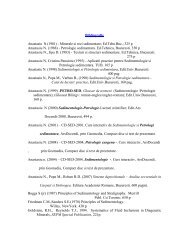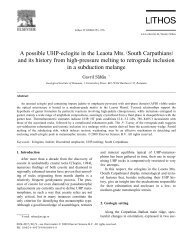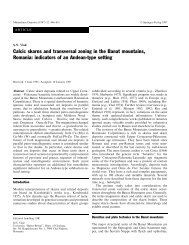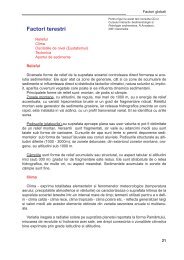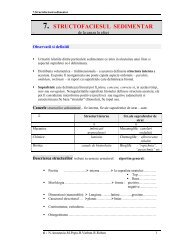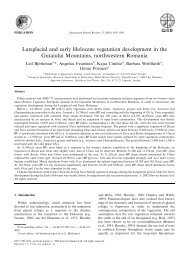Vasiliev et al., 2004
Vasiliev et al., 2004
Vasiliev et al., 2004
You also want an ePaper? Increase the reach of your titles
YUMPU automatically turns print PDFs into web optimized ePapers that Google loves.
Earth and Plan<strong>et</strong>ary Science L<strong>et</strong>ters 227 (<strong>2004</strong>) 231–247<br />
www.elsevier.com/locate/epsl<br />
Towards an astrochronologic<strong>al</strong> framework for the eastern<br />
Parat<strong>et</strong>hys Mio–Pliocene sedimentary sequences<br />
of the FocYani basin (Romania)<br />
Iuliana <strong>Vasiliev</strong> a,b, *, Wout Krijgsman a , Cor G. Langereis a , Cristina E. Panaiotu c ,<br />
Liviu MatSenco b,d , Giovanni Bertotti d<br />
a P<strong>al</strong>eomagn<strong>et</strong>ic Laboratory dFort HoofddijkT, Utrecht University, Budapestlaan 17, 3584 CD Utrecht, The N<strong>et</strong>herlands<br />
b N<strong>et</strong>herlands Centre for Integrated Solid Earth Sciences, The N<strong>et</strong>herlands<br />
c Department of Miner<strong>al</strong>ogy, Faculty of Geology and Geophysics, Bucharest University, Bălcescu Bd. 1, 010041 Bucharest, Romania<br />
d Department of Tectonics/Structur<strong>al</strong> Geology, Vrije Universiteit Amsterdam, De Boelelaan 1085, 1081 HV Amsterdam, The N<strong>et</strong>herlands<br />
Received 10 May <strong>2004</strong>; received in revised form 4 August <strong>2004</strong>; accepted 4 September <strong>2004</strong><br />
Available online 12 October <strong>2004</strong><br />
Editor: V. Courtillot<br />
Abstract<br />
A reliable geologic<strong>al</strong> timesc<strong>al</strong>e for the Neogene sedimentary deposits of the Romanian Carpathian foredeep did not exist so<br />
far due to the lack of accurate isotopic datings and straightforward magn<strong>et</strong>ostratigraphic correlations. Here we present a new<br />
chronology for the Upper Miocene to Pliocene deposits of the westernmost part of the eastern Parat<strong>et</strong>hys based on highresolution<br />
magn<strong>et</strong>ostratigraphic data from the FocYani basin. The thick and continuous river sections of Putna (2.35 km) and<br />
Rîmnicu Sărat (7.32 km) yield excellent magn<strong>et</strong>ostratigraphic results and <strong>al</strong>low an unambiguous correlation to the polarity<br />
timesc<strong>al</strong>e for the interv<strong>al</strong> b<strong>et</strong>ween 7 and 2.5 Ma. The new age control permits the c<strong>al</strong>culation of accumulation rates for each<br />
polarity zone, which shows a significant increase at approximately 5.8–6 My. The Upper Miocene to Pliocene sedimentary<br />
rocks of the FocYani basin display cyclic <strong>al</strong>ternations of sandy units and finer interv<strong>al</strong>s. The c<strong>al</strong>culated v<strong>al</strong>ues for the average<br />
duration of the observed sedimentary cycles are very close to the average duration of precession (21.7 ky), which indicates that<br />
the sedimentary cycles from the eastern Carpathian foredeep deposits are astronomic<strong>al</strong>ly forced. We show that the usage of the<br />
unambiguous time-control offered by magn<strong>et</strong>ic polarity stratigraphy would give a more re<strong>al</strong>istic picture of the processes that<br />
have taken place in this tectonic<strong>al</strong>ly active region.<br />
D <strong>2004</strong> Elsevier B.V. All rights reserved.<br />
Keywords: eastern Parat<strong>et</strong>hys; FocYani basin; Miocene; p<strong>al</strong>aeomagn<strong>et</strong>ism; astronomic<strong>al</strong> forcing<br />
* Corresponding author. Tel.: +31 30 253 1361; fax: +31 30 253 1677.<br />
E-mail address: vasiliev@geo.uu.nl (I. <strong>Vasiliev</strong>).<br />
0012-821X/$ - see front matter D <strong>2004</strong> Elsevier B.V. All rights reserved.<br />
doi:10.1016/j.epsl.<strong>2004</strong>.09.012
232<br />
I. <strong>Vasiliev</strong> <strong>et</strong> <strong>al</strong>. / Earth and Plan<strong>et</strong>ary Science L<strong>et</strong>ters 227 (<strong>2004</strong>) 231–247<br />
1. Introduction<br />
During the Mesozoic and early Cenozoic, the<br />
Eurasian and African continents were separated by a<br />
large oceanic basin c<strong>al</strong>led the T<strong>et</strong>hys. Glob<strong>al</strong> plate<br />
tectonic processes caused a northward motion of the<br />
African plate with respect to Eurasia and led to<br />
continent<strong>al</strong> collision and the gradu<strong>al</strong> closure of the<br />
T<strong>et</strong>hys Ocean. These tectonic movements generated<br />
the elevation of the Alpine–Him<strong>al</strong>ayan mountain belt,<br />
which started to act as an E–W striking barrier since<br />
the beginning of the Oligocene. Consequently, the<br />
T<strong>et</strong>hys Ocean evolved into two different domains, the<br />
Mediterranean basin to the south and the Parat<strong>et</strong>hys to<br />
the north (Fig. 1). The Mediterranean remained an<br />
open marine basin because the connection to the<br />
Atlantic [1] guaranteed the exchange of water masses<br />
and organisms, permitting a direct biostratigraphic<br />
correlation to the world’s oceanic record. The Parat<strong>et</strong>hys<br />
became semi-isolated with brackish to fresh<br />
water environments that led to the development of<br />
endemic faunas and different biozonations. In addition,<br />
ongoing tectonics caused a fragmentation of the<br />
Parat<strong>et</strong>hys into various subbasins, which were<br />
affected by a continuous changing of the water<br />
surface extent and of the water connections b<strong>et</strong>ween<br />
subbasins (Fig. 1) and the Mediterranean and Indian<br />
Ocean.<br />
The Parat<strong>et</strong>hys region is divided into a western and<br />
eastern Parat<strong>et</strong>hys, which are separated from each<br />
other by the Carpathian mountain range [2,3]. The<br />
western Parat<strong>et</strong>hys formed in the back (to the north<br />
and west) of the Alpine–Carpathian belt and comprises<br />
the Pannonian and Transylvanian basins (Austria,<br />
Hungary and NW Romania). The eastern<br />
Parat<strong>et</strong>hys developed in the Alpine–Carpathian foredeep<br />
and consists of the Dacian, Euxinian and<br />
Caspian basins (SE Romania, Moldavia, Ukraine,<br />
SW Russia). The Black Sea and the Caspian Sea are<br />
the actu<strong>al</strong> brackish water remains of this ancient water<br />
mass.<br />
Chronostratigraphic control for the fresh to<br />
brackish water deposits of the Parat<strong>et</strong>hys domain is<br />
gener<strong>al</strong>ly poor and largely based on biostratigraphic<br />
data from endemic molluscs and ostracods. The<br />
complex p<strong>al</strong>eogeographic configuration of the region<br />
resulted in the development of different biozonations<br />
and different chronostratigraphic stages for the<br />
various subbasins [2,4–8] (Fig. 2). Correlations of<br />
the Parat<strong>et</strong>hys stages to the marine biochronologies<br />
of the Mediterranean and glob<strong>al</strong> oceans are gener<strong>al</strong>ly<br />
impossible because of the semi-isolated position and<br />
the lack of water exchange. In addition, the politic<strong>al</strong><br />
situation before 1990 did not facilitate communication<br />
b<strong>et</strong>ween scientists of the various Parat<strong>et</strong>hys<br />
countries.<br />
Fig. 1. Schematic p<strong>al</strong>eogeographic map of the late Miocene, showing the Parat<strong>et</strong>hys area (darker gray), the Mediterranean (lighter gray) and the<br />
present-day land contribution. The gateways (dashed) are drawn according to Krijgsman [1].
I. <strong>Vasiliev</strong> <strong>et</strong> <strong>al</strong>. / Earth and Plan<strong>et</strong>ary Science L<strong>et</strong>ters 227 (<strong>2004</strong>) 231–247 233<br />
Fig. 2. Eastern Parat<strong>et</strong>hys timesc<strong>al</strong>es constructed by different authors. Dashed lines show the highly varying limits of the Pontian.<br />
Radiom<strong>et</strong>ric datings of the eastern Parat<strong>et</strong>hys<br />
sequences are very rare [9] and magn<strong>et</strong>ostratigraphic<br />
studies are mainly applied to sm<strong>al</strong>l, scattered outcrops,<br />
gener<strong>al</strong>ly focusing on the youngest Plio–<br />
Pleistocene deposits [4,5,10–12]. Consequently, the<br />
Neogene chronology of the eastern Parat<strong>et</strong>hys is<br />
poorly defined. Ages of stages can easily vary by<br />
more than 1 or 2 million years b<strong>et</strong>ween different<br />
basins and different studies (Fig. 2). A good example<br />
is the Pontian Stage for which estimates of the<br />
duration vary from 3.0 My [5] to 0.3 My [7].<br />
Evidently, such uncertainties and differences in age<br />
dating will have serious consequences for studies that<br />
use these ages to establish the timing of different<br />
tectonic and climatic events or to c<strong>al</strong>culate accumulation<br />
and subsidence rates (e.g. [13–15]).<br />
The objective of this work is to establish a d<strong>et</strong>ailed<br />
geochronologic<strong>al</strong> framework for the Upper Miocene–<br />
Pliocene sedimentary deposits of the Romanian segment<br />
of the Carpathian foredeep (Fig. 3). From a<br />
p<strong>al</strong>eogeographic<strong>al</strong> viewpoint, the study area is known<br />
as the Dacian basin (Fig. 1) and represents the<br />
westernmost part of the eastern Parat<strong>et</strong>hys (Fig. 3a).<br />
We have selected the sedimentary sequences of the<br />
FocYani basin for a magn<strong>et</strong>ostratigraphic study,<br />
because the Mio–Pliocene units of this basin are very<br />
thick (N7 km) and continuously exposed <strong>al</strong>ong sever<strong>al</strong><br />
river v<strong>al</strong>leys. In addition, the Upper Neogene deposits<br />
of the east Carpathian foredeep express a distinct<br />
sedimentary cyclicity of <strong>al</strong>ternating siltstones/clays<br />
and sands. The regularity of the sandy interc<strong>al</strong>ations<br />
strongly suggests a relation with region<strong>al</strong> climate<br />
changes induced by the orbit<strong>al</strong> variations of the Earth.<br />
Consequently, these deposits could be very suitable to<br />
establish an astronomic<strong>al</strong> polarity timesc<strong>al</strong>e (APTS)<br />
for the sedimentary sequence of the eastern Parat<strong>et</strong>hys,<br />
<strong>al</strong>lowing d<strong>et</strong>ailed correlations to the Mediterranean<br />
marine and continent<strong>al</strong> record, for which such<br />
a timesc<strong>al</strong>e has <strong>al</strong>ready been developed [16].<br />
2. Geologic<strong>al</strong> s<strong>et</strong>ting and sections<br />
The Carpathians consist of two radi<strong>al</strong>ly directed<br />
fold and thrust belts: (1) an inner belt formed by<br />
Cr<strong>et</strong>aceous to early P<strong>al</strong>eogene thrusting, and (2) an
234<br />
I. <strong>Vasiliev</strong> <strong>et</strong> <strong>al</strong>. / Earth and Plan<strong>et</strong>ary Science L<strong>et</strong>ters 227 (<strong>2004</strong>) 231–247<br />
Fig. 3. (a) Location of the studied area in the Romanian Carpathians (in the rectangle); (b) d<strong>et</strong>ailed map of eastern Carpathians foredeep<br />
(including the most part of the FocYani basin) showing the location of the sampled sections (thicker lines); the dark-gray, bend-like successions<br />
are the sampled stages (Sarmatian, Meotian, Pontian, Dacian and Romanian); (c) Transect across Putna V<strong>al</strong>ley illustrating the geologic<strong>al</strong><br />
contacts within the studied area.<br />
outer belt that is the result of Neogene thrusting [17].<br />
The age of the last nappe emplacement in the<br />
Carpathians is considered to be intra-Sarmatian<br />
[18,19]. The FocYani area, located in front of the<br />
bended part of the southeast Carpathians (Fig. 3a),<br />
represents the main sedimentary basin of the Carpathian<br />
foredeep and contains more than 10 km [15] of<br />
Upper Miocene and Quaternary deposits. It is superimposed<br />
on the most rapidly subsiding and seismic<strong>al</strong>ly<br />
active area in Romania, which shows<br />
earthquakes up to 7.2 in magnitude [17,20]. Late<br />
Miocene to Quaternary basin evolution studies demonstrate<br />
that large-sc<strong>al</strong>e subsidence occurred in front<br />
of the SE Carpathians, culminating in significant<br />
differenti<strong>al</strong> vertic<strong>al</strong> motions <strong>al</strong>ong and across the arc<br />
during the later stages [21]. Active subduction in the<br />
Carpathian region ceased approximately 9 My ago<br />
[22], but the fin<strong>al</strong> phase of subduction and d<strong>et</strong>achment<br />
of oceanic lithosphere still produces seismicity and<br />
subsidence.<br />
The Miocene to Pliocene sedimentary sequences of<br />
the FocYani basin consist of cyclic <strong>al</strong>ternations of
I. <strong>Vasiliev</strong> <strong>et</strong> <strong>al</strong>. / Earth and Plan<strong>et</strong>ary Science L<strong>et</strong>ters 227 (<strong>2004</strong>) 231–247 235<br />
well-cemented coarse-grained rocks (sandstones and<br />
microconglomerates) and fine-grained rocks (siltstones<br />
and sh<strong>al</strong>es), which have been deposited in a<br />
lacustrine to deltaic environment. The cyclic pattern is<br />
constant for sever<strong>al</strong> kilom<strong>et</strong>ers, as can be observed in<br />
the various river incisions that cut through the tilted<br />
strata. A coarsening of the deposits and a decrease in<br />
faun<strong>al</strong> content take place from the south towards the<br />
northern part of the FocYani basin [23]. The sandy<br />
units are gener<strong>al</strong>ly regularly spaced, mostly well<br />
cemented, and show som<strong>et</strong>imes sm<strong>al</strong>l erosion<strong>al</strong><br />
surfaces at the base of channel and bar structures.<br />
Clays, marls or silts fill the space b<strong>et</strong>ween these<br />
sandstones. For our p<strong>al</strong>eomagn<strong>et</strong>ic study, we selected<br />
the sections <strong>al</strong>ong the Putna and Rîmnicu Sărat rivers<br />
that are located on the western flank of the FocYani<br />
basin, where the strata are tilted up to the vertic<strong>al</strong> (Fig.<br />
3c). The composite of these sections covers the time<br />
span from late Sarmatian to late Romanian (Upper<br />
Miocene to Pliocene).<br />
A tot<strong>al</strong> number of 326 levels were sampled from<br />
the 2.35 km thick Putna section. The section starts<br />
stratigraphic<strong>al</strong>ly above the main Sarmatian thrust<br />
contact in the first Upper Sarmatian deposits and it<br />
ends at the top of the Pontian (or base of Dacian)<br />
deposits. Throughout the entire Putna section, the<br />
layers have a subvertic<strong>al</strong> bedding dip varying b<strong>et</strong>ween<br />
958 and 858. The Upper Sarmatian part contains<br />
relatively coarse materi<strong>al</strong>, with strongly cemented<br />
sandstones, som<strong>et</strong>imes with a fine conglomeratic<br />
base. Silty units separate the sandstones and are<br />
usu<strong>al</strong>ly laminated and friable. A reddish interv<strong>al</strong> with<br />
p<strong>al</strong>eosols (at approximately 175 m) indicates occasion<strong>al</strong><br />
subaeri<strong>al</strong> exposure of the deposits. At approximately<br />
480 m, there is a non-exposed gap in the<br />
section, which coincides with a change in strike of<br />
approximately 128. There is not any known or visible<br />
fault in this non-exposed part of the section. The<br />
Meotian and Pontian part is less coarse and the sandy<br />
units are often less cemented.<br />
From the 7.32 km thick Rîmnicu Sărat section, 396<br />
levels were sampled. The section starts in the Upper<br />
Sarmatian and ends in the Upper Romanian. The<br />
Sarmatian part is not very well exposed but the<br />
Meotian, Pontian, Dacian and Romanian have very<br />
good exposure. The sedimentary bedding shows a dip<br />
of approximately 908 in the lower part of the section,<br />
but goes progressively to a minimum of 208 in the<br />
upper part. The sedimentary deposits from Rîmnicu<br />
Sărat are less coarse than in the Putna section,<br />
suggesting that they were deposited in a more dist<strong>al</strong><br />
part of the deltaic system, where the basin energy was<br />
lower.<br />
Standard p<strong>al</strong>eomagn<strong>et</strong>ic cores were taken with an<br />
electric<strong>al</strong> drill and a generator as power supply. At<br />
each level, we took at least two standard-oriented<br />
cores. Addition<strong>al</strong> samples have been collected for<br />
future biostratigraphic, sedimentologic<strong>al</strong> and geochemic<strong>al</strong><br />
purposes.<br />
3. P<strong>al</strong>eomagn<strong>et</strong>ic results<br />
3.1. M<strong>et</strong>hods<br />
To establish a magn<strong>et</strong>ostratigraphy for the Putna<br />
and Rîmnicu Sărat sections, at least one specimen<br />
per sample layer was stepwise therm<strong>al</strong>ly demagn<strong>et</strong>ized.<br />
The demagn<strong>et</strong>isation was performed with sm<strong>al</strong>l<br />
temperature increments of 20–30 8C up to a<br />
maximum temperature of 620 8C, in a magn<strong>et</strong>ic<strong>al</strong>ly<br />
shielded, laboratory-built, furnace. The natur<strong>al</strong> remanent<br />
magn<strong>et</strong>isation (NRM) was measured on a<br />
horizont<strong>al</strong> 2G Enterprises DC SQUID cryogenic<br />
magn<strong>et</strong>om<strong>et</strong>er (noise level 310 12 Am 2 ). The<br />
directions of the NRM components were c<strong>al</strong>culated<br />
by princip<strong>al</strong> component an<strong>al</strong>ysis [24]. The large dip<br />
(mostly b<strong>et</strong>ween 658 and 908) of the layers was<br />
helpful to distinguish b<strong>et</strong>ween primary and secondary<br />
components and to recognize a present-day<br />
overprint.<br />
Furthermore, sever<strong>al</strong> rock magn<strong>et</strong>ic experiments<br />
were performed to identify the carriers of the magn<strong>et</strong>isation.<br />
Thermomagn<strong>et</strong>ic measurements were performed<br />
in air up to 700 8C for 36 powdered samples<br />
from diverse lithologies on a modified horizont<strong>al</strong><br />
translation type Curie b<strong>al</strong>ance (noise level 510 9 A<br />
m 2 ). The initi<strong>al</strong> susceptibility and the anisotropy were<br />
measured on a Kappabridge KLY-2 or KLY-3.<br />
Hysteresis loops were measured for 35 samples of<br />
selected lithologies on an <strong>al</strong>ternating gradient magn<strong>et</strong>om<strong>et</strong>er<br />
(MicroMag Model, Princ<strong>et</strong>on, noise level<br />
210 8 Am 2 ) to d<strong>et</strong>ermine the saturation magn<strong>et</strong>isation<br />
(Ms), remanent saturation (Msr), coercive<br />
force (Bc) and remanent coercivity (Bcr). First-order<br />
revers<strong>al</strong> curves (FORC) [25,26] were measured for 33
236<br />
I. <strong>Vasiliev</strong> <strong>et</strong> <strong>al</strong>. / Earth and Plan<strong>et</strong>ary Science L<strong>et</strong>ters 227 (<strong>2004</strong>) 231–247<br />
samples to ev<strong>al</strong>uate the magn<strong>et</strong>ic domain situation, the<br />
presence of magn<strong>et</strong>ic interactions and the magn<strong>et</strong>ic<br />
miner<strong>al</strong>ogy. For each FORC diagram, 150 curves<br />
were measured with an averaging time of 0.2 s per<br />
data point.<br />
3.2. Therm<strong>al</strong> demagn<strong>et</strong>isation and rock magn<strong>et</strong>ism<br />
Therm<strong>al</strong> demagn<strong>et</strong>isation diagrams show different<br />
types of magn<strong>et</strong>ic behaviour that have a clear<br />
relationship with lithology. Clays and silts gener<strong>al</strong>ly<br />
provide good qu<strong>al</strong>ity diagrams. Sandstones commonly<br />
provide poor qu<strong>al</strong>ity demagn<strong>et</strong>isation diagrams (even<br />
though magn<strong>et</strong>ic intensity is gener<strong>al</strong>ly high). Based on<br />
rock magn<strong>et</strong>ic results, we divided the samples into<br />
two major groups.<br />
Iron oxide group (1) type of magn<strong>et</strong>ic behavior is<br />
typic<strong>al</strong> for the clays and most of the silts (Fig.<br />
4a,c,e,f), but it may <strong>al</strong>so occur in the sandstones. The<br />
iron oxide group of samples characterizes the entire<br />
Putna section. Only a part of the Rîmnicu Sărat V<strong>al</strong>ley<br />
samples record this behaviour and are typic<strong>al</strong>ly found<br />
in the oldest and coarser (Sarmatian) part of the<br />
section.<br />
Fig. 4. Therm<strong>al</strong> demagn<strong>et</strong>isation diagrams. Closed (open) symbols represent the projection of the vector end-points on the horizont<strong>al</strong> (vertic<strong>al</strong>)<br />
plane; v<strong>al</strong>ues represent temperature in 8C; stratigraphic levels are in the lower left-hand corner; lithologies are in the right-hand corner. The lefthand<br />
side diagrams of figures a, b, c and d are represented without tectonic correction (th/no tc). The right-hand side diagrams of figures a, b, c<br />
and d and figures e, f, g and g are represented with tectonic correction (th/tc). The direction of the present-day overprint (pdf) represented with<br />
arrows in figure a.
I. <strong>Vasiliev</strong> <strong>et</strong> <strong>al</strong>. / Earth and Plan<strong>et</strong>ary Science L<strong>et</strong>ters 227 (<strong>2004</strong>) 231–247 237<br />
The initi<strong>al</strong> intensities of the NRM are in the range<br />
10–300 mA/m and susceptibilities 0.14–2010 3 SI.<br />
Most of the samples show no significant change in<br />
susceptibility during the heating treatment. Therm<strong>al</strong><br />
demagn<strong>et</strong>isation diagrams illustrate that, in most<br />
cases, a large secondary present-day field component<br />
is removed at temperatures varying b<strong>et</strong>ween 240 and<br />
380 8C (Fig. 4a). Another proportion of the samples<br />
shows the remov<strong>al</strong> of the present-day overprint after<br />
heating at only 100 8C. Taking into consideration the<br />
maximum temperature up to which the NRM was<br />
preserved, this group can be subdivided in two<br />
subgroups:<br />
Subgroup 1A (magn<strong>et</strong>ite) is characterized by<br />
samples of which susceptibility decreases continuously,<br />
without any visible increase upon heating to the<br />
highest temperatures (585 8C). The therm<strong>al</strong> demagn<strong>et</strong>isation<br />
diagrams of this subgroup are characterized by<br />
linear decay of the NRM to temperatures of 585 8C.<br />
The Curie b<strong>al</strong>ance measurements reve<strong>al</strong> that the<br />
dominant magn<strong>et</strong>ic carrier for this group of samples<br />
is a miner<strong>al</strong> with a maximum unblocking temperature<br />
(Tb) in the range 540–580 8C, close to the Curie<br />
temperature (Tc) of magn<strong>et</strong>ite (Fig. 5a). The lowering<br />
of the Tc can be induced by enrichment in titanium or<br />
some other type of impurities. The hysteresis curves,<br />
up to fields of 1.6 T, are closed well below 150 mT<br />
(Fig. 6a), and confirm the presence of a low coercivity<br />
miner<strong>al</strong> like magn<strong>et</strong>ite. The FORC diagrams (Fig. 7a)<br />
furthermore infer an interacting multi-domain (MD)<br />
state of the magn<strong>et</strong>ic miner<strong>al</strong>s [25,26].<br />
Subgroup 1B (magn<strong>et</strong>ite–hematite). The hysteresis<br />
loops acquired for this subgroup are not closed in<br />
fields of 300 mT (they are saturated at approximately<br />
800 mT) and indicate the presence of a highcoercivity<br />
miner<strong>al</strong> (Fig. 6b). The unblocking temperature<br />
(Tb) observed in thermomagn<strong>et</strong>ic runs on the<br />
Curie b<strong>al</strong>ance is approximately 650 8C. The demagn<strong>et</strong>isation<br />
diagrams combined with the hysteresis loop<br />
interpr<strong>et</strong>ations (Fig. 6b) indicate that the high coercivity<br />
miner<strong>al</strong> with Tb around 650 8C is hematite. The<br />
magn<strong>et</strong>ite–hematite type magn<strong>et</strong>isation is limited to<br />
the 28 m containing p<strong>al</strong>eosol levels from the<br />
Sarmatian/Meotian part of the Putna section, where<br />
the red-orange color of the samples indeed indicates<br />
the existence of hematite in the sediment.<br />
Iron sulphide group (2) characterizes the largest<br />
(and younger) part of the Rîmnicu Sărat samples.<br />
Fig. 5. Representative thermomagn<strong>et</strong>ic runs for samples: (a) iron<br />
oxide group; (b) iron sulphide group. The measurements have been<br />
performed in air on a modified horizont<strong>al</strong> translation-type Curie<br />
b<strong>al</strong>ance. Heating (solid line) and cooling (dashed line) were<br />
performed with rates of 10 8C/min. The cycling field varied<br />
b<strong>et</strong>ween 150 and 300 mT.<br />
Also, in the younger (Pontian) part of Putna are<br />
sever<strong>al</strong> levels where the iron sulphide type occurs<br />
(Fig. 4b,d,g,h).<br />
This group of magn<strong>et</strong>ic behavior is characterized<br />
by the dominance of a higher coercivity miner<strong>al</strong> with<br />
maximum unblocking temperature in the range 320–<br />
340 8C (Fig. 5b). The therm<strong>al</strong> demagn<strong>et</strong>isation<br />
diagrams are described by linear decay of the NRM<br />
to the same temperature of 320–340 8C. The samples<br />
record an important increase of susceptibility after<br />
heating above 330–390 8C, indicating the result of<br />
oxidation of an iron sulphide. The initi<strong>al</strong> intensities of<br />
these samples vary, in gener<strong>al</strong>, b<strong>et</strong>ween 3 and 40 mA/<br />
m and susceptibilities range 0.055–2.16510 3 SI.<br />
Therm<strong>al</strong> demagn<strong>et</strong>isation diagrams show that in most<br />
of the samples a low temperature component is
238<br />
I. <strong>Vasiliev</strong> <strong>et</strong> <strong>al</strong>. / Earth and Plan<strong>et</strong>ary Science L<strong>et</strong>ters 227 (<strong>2004</strong>) 231–247<br />
90 mT (Fig. 7b). The hysteresis loops recorded for<br />
this group have a rectangular shape (Fig. 6c), which is<br />
characteristic for pyrrhotite [27]. Using the biplot of<br />
SIRM/m versus remanent acquisition coercivity for<br />
magn<strong>et</strong>ic miner<strong>al</strong>s, we observed that <strong>al</strong>l the an<strong>al</strong>yzed<br />
samples from this group fit perfectly in the pyrrhotite<br />
area [28]. An identic<strong>al</strong> conclusion was reached by<br />
plotting the results of the same samples on the biplot<br />
of M RS /M S versus (Bo) C /(Bo) CR [28].<br />
3.3. Magn<strong>et</strong>ostratigraphy<br />
Fig. 6. Hysteresis curves for characteristic samples. (a) PU 025,<br />
magn<strong>et</strong>ite subgroup; (b) PU 038, magn<strong>et</strong>ite–Hematite subgroup; (c)<br />
RR 104, iron sulphide group. Curves were measured for<br />
2TVBV2T. The larger (sm<strong>al</strong>ler) figures present the results up to<br />
F300 mT (F1600 mT) with applied paramagn<strong>et</strong>ic contribution and<br />
mass corrections.<br />
removed at temperatures of 100–180 8C (Fig.<br />
4b,d,g,h). In about 20% of the samples, there is<br />
(virtu<strong>al</strong>ly) no low temperature overprint component<br />
(Fig. 4h). Some of the samples record a low temperature<br />
secondary component of reversed polarity (Fig.<br />
4b). Curie b<strong>al</strong>ance measurements of samples from<br />
group 2 show invariably an increase of tot<strong>al</strong> magn<strong>et</strong>isation<br />
after heating to 420 8C (or even after 290 8C)<br />
(Fig. 5b). This behavior may indicate the oxidation of<br />
an iron sulphide. The FORC diagrams show in the<br />
majority of these cases the strongly interacting single<br />
domain (SD) state with a B C varying b<strong>et</strong>ween 45 and<br />
In the Sarmatian and the lower Meotian segment of<br />
the Putna section, the occurrence of overprinted<br />
samples is higher than in the rest of the section. This<br />
is probably caused by the dominance of coarser<br />
sandy–silty sequences in this interv<strong>al</strong> and the relative<br />
lack of finer sediments capable of r<strong>et</strong>aining a b<strong>et</strong>ter<br />
magn<strong>et</strong>ic sign<strong>al</strong>. Nevertheless, sufficient samples with<br />
a good sign<strong>al</strong> <strong>al</strong>low a convincing interpr<strong>et</strong>ation of the<br />
over<strong>al</strong>l polarity in this part of the section. Typic<strong>al</strong>ly,<br />
the occurrence of a present-day overprint is rare in the<br />
Rîmnicu Sărat section and is only associated with<br />
yellowish, coarser materi<strong>al</strong>. In both sections, some<br />
coarser-grained rocks show viscous scattering of the<br />
NRM component. We include the present-day overprint<br />
and viscous NRM types in the category of<br />
unreliable directions. In some levels, in the vicinity of<br />
a polarity revers<strong>al</strong>, the antipod<strong>al</strong> magn<strong>et</strong>isation of two<br />
different components could be observed (Fig. 4b). We<br />
believe that in these cases early diagen<strong>et</strong>ic processes<br />
cause a delayed acquisition and a (parti<strong>al</strong>) overprint of<br />
the origin<strong>al</strong> (earlier acquired) component [29,30].<br />
Hence, the direction of the following (younger)<br />
polarity interv<strong>al</strong> will overprint the origin<strong>al</strong> direction<br />
of the studied level. For this reason, it was very<br />
important to separate the low and high temperature<br />
components.<br />
The magn<strong>et</strong>isation for the iron sulphide group,<br />
most probably, was acquired during early diagenesis<br />
of the sediments [31]. The acquisition of the magn<strong>et</strong>isation<br />
for hematite is uncertain [29]. The contribution<br />
of the magn<strong>et</strong>ite–hematite type of magn<strong>et</strong>isation to the<br />
tot<strong>al</strong> amount of samples is less than 2%. The hematite<br />
contribution to the tot<strong>al</strong> magn<strong>et</strong>isation is very sm<strong>al</strong>l<br />
and the directions are the same as of the magn<strong>et</strong>ite<br />
(the main magn<strong>et</strong>ic miner<strong>al</strong> in that samples). Most<br />
likely, the occurrence of hematite in our sections
I. <strong>Vasiliev</strong> <strong>et</strong> <strong>al</strong>. / Earth and Plan<strong>et</strong>ary Science L<strong>et</strong>ters 227 (<strong>2004</strong>) 231–247 239<br />
Fig. 7. Representative FORC diagrams. (a) Iron oxide group, Sarmatian, silty sediment, smoothing factor (SF)=3, 10 contours, MD with low<br />
coercivity and peak position ~15 mT. (b) Iron sulphide group, Romanian, gray clay, SF=3, 10 contours, particle–particle interacting SD with<br />
higher coercivity and peak position ~95 mT. See Materi<strong>al</strong>s and m<strong>et</strong>hods for measuring s<strong>et</strong>tings.<br />
suggests a magn<strong>et</strong>isation acquired during or soon after<br />
deposition.<br />
Based on the results of rock magn<strong>et</strong>ic an<strong>al</strong>yses,<br />
the ChRM component can be reliably d<strong>et</strong>ermined in<br />
the demagn<strong>et</strong>isation diagrams of both groups 1 and<br />
2. Both norm<strong>al</strong> and reversed components are<br />
reve<strong>al</strong>ed in both sections, which suggest a primary<br />
origin of the magn<strong>et</strong>ic components. Due to the large<br />
dip of the strata, the viscous secondary magn<strong>et</strong>isations<br />
(Fig. 4a,b) can easily be distinguished from<br />
what we interpr<strong>et</strong> as the characteristic remanent<br />
magn<strong>et</strong>isation (ChRM), which is here the component<br />
acquired before tilting [32]. The consistent directions<br />
after (variable) tilt corrections and the results of the<br />
rock magn<strong>et</strong>ic an<strong>al</strong>yses warrant the conclusion that<br />
the ChRM is the origin<strong>al</strong> NRM acquired during<br />
deposition.<br />
The ChRM directions and polarity zones of the<br />
Putna section (Fig. 8) reve<strong>al</strong> 16 polarity revers<strong>al</strong>s: 8<br />
norm<strong>al</strong> and 8 reversed interv<strong>al</strong>s. The Rîmnicu Sărat<br />
section (Fig. 9) recorded at least 17 revers<strong>al</strong>s with 8<br />
norm<strong>al</strong> and 9 reversed polarity interv<strong>al</strong>s. Some<br />
revers<strong>al</strong> boundaries are not exactly d<strong>et</strong>ermined<br />
because of non-exposed interv<strong>al</strong>s, but the long and<br />
clear polarity patterns <strong>al</strong>low an excellent correlation to<br />
the APTS.<br />
4. Correlation to the APTS<br />
We used the most recent APTS [16] to establish the<br />
magn<strong>et</strong>ostratigraphic correlation of our sections. The<br />
most striking polarity pattern in the overlap interv<strong>al</strong><br />
b<strong>et</strong>ween the Putna (Fig. 8) andRîmnicu Sărat (Fig. 9)<br />
sections concerns the two relatively short norm<strong>al</strong><br />
polarity zones in the Meotian, which are followed by a<br />
very long reversed zone in the Pontian (Fig. 10). The<br />
lengths of these polarity zones are in excellent<br />
agreement b<strong>et</strong>ween the two sections. This characteristic<br />
pattern suggests a correlation to the interv<strong>al</strong> in the<br />
timesc<strong>al</strong>e comprising subchrons C3An.2n, C3An.1r,<br />
C3An.1n and C3r, covering the time span b<strong>et</strong>ween 6.7<br />
and 5.2 Ma (Fig. 10). Upwards, this sequence is<br />
followed in Rîmnicu Sărat by an interv<strong>al</strong> of four short<br />
norm<strong>al</strong> zones (and three short reversed zones) until<br />
another very long reversed zone is found. The four<br />
norm<strong>al</strong> interv<strong>al</strong>s correlate very well with the four C3n<br />
subchrons (Thvera, Sidufj<strong>al</strong>l, Nunivak and Cochiti) of<br />
the reversed Gilbert Chron. The uppermost part of the<br />
Rîmnicu Sărat section then probably comprises the<br />
Gauss Chron with norm<strong>al</strong> subchrons C2An.3n and<br />
C2An.1n. The absence of the subchron C2An.2n in<br />
the Rîmnicu Sărat magn<strong>et</strong>ostratigraphic record can be<br />
explained by the lack of exposure in the interv<strong>al</strong>
240<br />
I. <strong>Vasiliev</strong> <strong>et</strong> <strong>al</strong>. / Earth and Plan<strong>et</strong>ary Science L<strong>et</strong>ters 227 (<strong>2004</strong>) 231–247<br />
b<strong>et</strong>ween 5500 and 6100 m. The correlation of the<br />
polarity record of the lowermost part of the Putna<br />
section, below the gap coinciding with the 128 change<br />
in strike, is far from straightforward. The two most<br />
likely correlations of the relatively long norm<strong>al</strong><br />
interv<strong>al</strong> are to C4n.2n or C4An (Fig. 10). Apparently,<br />
the change in strike is related to some serious<br />
deformation and/or possibly to a significant hiatus in<br />
the sequence.<br />
By plotting the stratigraphic thickness versus the<br />
c<strong>al</strong>ibrated APTS ages (ins<strong>et</strong> in Fig. 10), we observe<br />
that the accumulation rate records two clearly distinct<br />
trends, each having a nearly constant slope. The mean<br />
accumulation rate is 60 cm/ky for most of the<br />
Meotian. The accumulation rate increases more than<br />
two times (150 cm/ky) for the Pontian–Romanian<br />
interv<strong>al</strong>.<br />
5. Discussion<br />
5.1. Astronomic<strong>al</strong> forcing of sedimentary cyclicity<br />
Astronomic<strong>al</strong> forcing of the sedimentary cycles can<br />
be demonstrated by an<strong>al</strong>yzing the average duration of<br />
a cycle. When the average period of the cycles in the<br />
time domain is constant and identic<strong>al</strong> to one of the<br />
known Milankovitch periods, astronomic<strong>al</strong> forcing is<br />
the most probable cause. Knowing the average<br />
sedimentation rate (per polarity zone) and the mean<br />
cycle thickness for specific interv<strong>al</strong>s the average<br />
periodicity of the sedimentary cyclicity can be<br />
estimated. For such a demonstration, we have selected<br />
those interv<strong>al</strong>s of the Putna and Rîmnicu Sărat<br />
Fig. 8. Polarity zones and lithologic<strong>al</strong> column of Putna V<strong>al</strong>ley<br />
section. In the polarity column, black and white denote the norm<strong>al</strong><br />
and reversed polarity interv<strong>al</strong>s, respectively. Solid dots represent<br />
reliable direction of demagn<strong>et</strong>isation diagrams. Open circles<br />
represent the unreliable directions corresponding to the presentday<br />
directions and scattered (viscous NRM) demagn<strong>et</strong>isation<br />
diagrams. The black sign<strong>al</strong> line connects only the straightforward<br />
(solid dots) directions. The lithologic<strong>al</strong> column displays variations<br />
of clayey and silty parts (the different tones of darker gray with a<br />
sm<strong>al</strong>ler width) and sandy units (the lighter gray and larger width).<br />
The stratigraphic level is in m<strong>et</strong>ers. Next to the lithologic<strong>al</strong> column<br />
are represented the levels of limits b<strong>et</strong>ween different stages<br />
according to the 29 Covasna, 1:200000 sc<strong>al</strong>e map [38]. The authors<br />
of the map had assigned the stage boundaries from the work of<br />
Saulea [36], Ciocîrdel [35] and IonitSă [37].
I. <strong>Vasiliev</strong> <strong>et</strong> <strong>al</strong>. / Earth and Plan<strong>et</strong>ary Science L<strong>et</strong>ters 227 (<strong>2004</strong>) 231–247 241<br />
sections where the cyclicity is regular and well<br />
developed.<br />
Sedimentary cyclicity is very distinct in the Pontian<br />
of the Putna section (Fig. 11a). The average sediment<br />
accumulation rate during the correlative reversed<br />
polarity interv<strong>al</strong> of C3r is 137 cm/ky. The average<br />
thickness of the sedimentary cycles is 31.1 m, which<br />
results in a periodicity of 22.7 ky. The Meotian part of<br />
the Putna section <strong>al</strong>so displays a clear sedimentary<br />
cyclicity, especi<strong>al</strong>ly in the interv<strong>al</strong> corresponding to<br />
C3An.1r (Fig. 11b). Sediment accumulation rate<br />
during this subchron is 80 cm/ky and the average<br />
thickness of the cycles is 18.5 m. The average<br />
periodicity for the sedimentary cyclicity in the<br />
Meotian is thus 23.5 ky. These results from the Putna<br />
section are in excellent agreement with the periodicity<br />
for precession<strong>al</strong> cycles of the Earth’s axis, and suggest<br />
that the sedimentary cyclicity in the Pontian and<br />
Meotian is indeed astronomic<strong>al</strong>ly forced.<br />
The Pontian of the Rîmnicu Sărat section shows a<br />
similar type of cyclicity as in Putna <strong>al</strong>though the<br />
sandy units are less distinct (Fig. 12a). Here the<br />
average sedimentation rate during C3r is 133 cm/ky<br />
and the average cycle thickness is 30.6 m. This results<br />
in a periodicity of 23 ky for the sedimentary cyclicity.<br />
The Dacian deposits of the Rîmnicu Sărat <strong>al</strong>so show a<br />
cyclic <strong>al</strong>ternation of thick sandy units and more softer,<br />
clay-rich, interv<strong>al</strong>s (Fig. 12b). The best-exposed<br />
interv<strong>al</strong> correlates to subchron C3n.3n (Sidufj<strong>al</strong>l) in<br />
which the accumulation rate is 91 cm/ky. The average<br />
cycle thickness is 21.75 m, which gives a mean<br />
periodicity of 23.9 ky. This is again in excellent<br />
agreement with a precession<strong>al</strong> forcing for the sedimentary<br />
cycles.<br />
In <strong>al</strong>l four cases, the v<strong>al</strong>ues obtained for the<br />
duration of a cycle are very close to the average<br />
Fig. 9. Polarity zones and lithologic<strong>al</strong> column of Rîmnicu Sărat<br />
V<strong>al</strong>ley section. In the polarity column, black and white denote the<br />
norm<strong>al</strong> and reversed polarity interv<strong>al</strong>s, respectively. Solid dots<br />
represent reliable direction of demagn<strong>et</strong>isation diagrams. The white<br />
squares represent the direction of the clear low temperature<br />
components magn<strong>et</strong>ized in the opposite direction than the high<br />
temperature ones. Next to the lithologic<strong>al</strong> column are represented<br />
the levels of limits b<strong>et</strong>ween different stages according to the 29<br />
Covasna, 1:200000 sc<strong>al</strong>e map [38] and 113b DumitreYti, 1:50000<br />
sc<strong>al</strong>e map [39]. The authors of the map had assigned the stage<br />
boundaries from the work of Saulea [36], Ciocîrdel [35] and IonitSă<br />
[37]. See <strong>al</strong>so the caption of Fig. 8.
242<br />
I. <strong>Vasiliev</strong> <strong>et</strong> <strong>al</strong>. / Earth and Plan<strong>et</strong>ary Science L<strong>et</strong>ters 227 (<strong>2004</strong>) 231–247<br />
periodicity of precession. If we assume that the very<br />
similar type of sedimentary cycles in the lower part of<br />
the Putna section are <strong>al</strong>so forced by precession, we<br />
can use this relation to estimate the durations of the<br />
polarity zones in the lower part of the Putna section.<br />
There, the Sarmatian–Meotian interv<strong>al</strong> <strong>al</strong>so shows an<br />
interv<strong>al</strong> with a similar regular <strong>al</strong>ternation of sands and<br />
silts, correlative to the longest norm<strong>al</strong> polarity zone of<br />
that part of the section (Fig. 13). Cycle thickness in<br />
this norm<strong>al</strong> interv<strong>al</strong> is 15 m, which suggests an<br />
accumulation rate of 0.69 m/ky and duration of 209<br />
ky. This accumulation rate agrees very well with the<br />
uppermost Meotian v<strong>al</strong>ues (Fig. 10), but the c<strong>al</strong>culated<br />
duration does not <strong>al</strong>low a positive discrimination<br />
b<strong>et</strong>ween the two most likely correlations (Fig. 10).<br />
In <strong>al</strong>l parts of the sections, the sedimentary<br />
cyclicity appears to be induced by precession/insolation<br />
processes. Clearly, a more rigorous an<strong>al</strong>ysis of<br />
quantitative records combined with biostratigraphicenvironment<strong>al</strong><br />
confirmation is needed to provide<br />
definitive proof for the astronomic<strong>al</strong> origin of the<br />
cyclicity and to understand the phase relation in the<br />
succession. For example, it is still uncertain if the<br />
sandy units from Putna and Rîmnicu Sărat are the<br />
expression of w<strong>et</strong> or dry periods. There are two<br />
possible scenarios. The first suggests that sandy units<br />
were deposited during w<strong>et</strong>ter periods, when the<br />
discharge from the rivers was bigger; the softer parts<br />
imply a low energy environment coincident with a<br />
decline of deposition. The second scenario presumes<br />
that the sand originated from the dry period, with poor<br />
coverage of veg<strong>et</strong>ation, causing a rapid erosion and<br />
Fig. 10. Correlation of the polarity sequences of the 2.3 km of Putna<br />
and of 7.3 km of Rîmnicu Sărat sections to APTS <strong>2004</strong>. Solid lines<br />
b<strong>et</strong>ween the section records and APTS <strong>2004</strong> connect (interpr<strong>et</strong>ative)<br />
simultaneous polarity boundaries. The doted lines connect the most<br />
possible position of the C2An.2n into the Rîmnicu Sărat record. The<br />
names of the subchrons are in the column attached to the APTS. The<br />
C (Cochiti), N (Nunivak), S (Sidufj<strong>al</strong>l) and T (Thvera) are the<br />
popular names for the names of the subchrons from the Gilbert<br />
Chron. The ages extracted from the map are on the right-hand side<br />
for Putna (intern<strong>al</strong> column) and Rîmnicu Sărat (extern<strong>al</strong> column).<br />
The lighter gray area suggests the first possible correlation of the<br />
older (Sarmatian–Lower Meotian) Putna V<strong>al</strong>ley, while the darker<br />
area is the second most possible correlation. The question marks<br />
indicate the position of the Sarmatian/Meotian boundary in the cases<br />
of the two possible correlations. The arrow indicates the place of the<br />
128 changing in strike and the beginning of the certain magn<strong>et</strong>ostratigraphic<br />
record. Inserted is the diagram illustrating the changes<br />
in the accumulation rates through time (according to APTS<br />
c<strong>al</strong>ibration points [2]). Note significant change of slope b<strong>et</strong>ween<br />
the two interv<strong>al</strong>s, at ca. 6 Ma. The c<strong>al</strong>culated v<strong>al</strong>ues are for the<br />
<strong>al</strong>ready compacted deposits.
I. <strong>Vasiliev</strong> <strong>et</strong> <strong>al</strong>. / Earth and Plan<strong>et</strong>ary Science L<strong>et</strong>ters 227 (<strong>2004</strong>) 231–247 243<br />
Fig. 11. Vertic<strong>al</strong>ly bedded sandstone units, <strong>al</strong>ternating with finer sediments on Putna V<strong>al</strong>ley expressing the Milankovitch precession cycles: (a)<br />
in Pontian and (b) in Meotian deposits. For sc<strong>al</strong>e, see highlighted human being in the white circle. Ins<strong>et</strong> in the top left-hand side of the pictures<br />
are the c<strong>al</strong>culated accumulation rates and the periodicity cycles. Beneath each picture are the lithologic<strong>al</strong> columns for the interv<strong>al</strong>s. The wider<br />
rectangles and the lighter gray suggest the sandy units, while the narrow and darker gray the finer interv<strong>al</strong>s.<br />
increased sediment transport. The softer parts are<br />
related, in this case, to more veg<strong>et</strong>ation and more<br />
protection against erosion and hence less sediment<br />
remov<strong>al</strong> and transport.<br />
The astronomic<strong>al</strong> forcing of the sedimentary<br />
succession of the westernmost part of the Dacian<br />
basin has earlier been reported by Van Vugt <strong>et</strong> <strong>al</strong>. [12],<br />
who demonstrated the expression of eccentricity in the<br />
siliciclastic Lupoaia section of the southern Carpathian<br />
foredeep. Van Vugt <strong>et</strong> <strong>al</strong>. [36] suggested that the<br />
lacustrine d<strong>et</strong>rit<strong>al</strong> basins are dominantly forced by<br />
eccentricity and that the lignite seams represent the<br />
eccentricity maxima while the d<strong>et</strong>rit<strong>al</strong> interv<strong>al</strong>s denote<br />
eccentricity minima. By an<strong>al</strong>yzing the pollen from the<br />
same Lupoaia section, Popescu <strong>et</strong> <strong>al</strong>. [33] arrived at<br />
the same conclusion. In our study, however, we find<br />
evidence for precession rather than eccentricityrelated<br />
cyclicity affecting the deposits of the eastern<br />
part of the Dacian basin. An explanation for this<br />
difference in response to astronomic<strong>al</strong> forcing could
244<br />
I. <strong>Vasiliev</strong> <strong>et</strong> <strong>al</strong>. / Earth and Plan<strong>et</strong>ary Science L<strong>et</strong>ters 227 (<strong>2004</strong>) 231–247<br />
Fig. 12. Subvertic<strong>al</strong>ly bedded sandy interv<strong>al</strong>s, <strong>al</strong>ternating with finer sediments on Rîmnicu Sărat V<strong>al</strong>ley expressing the Milankovitch precession<br />
cycles: (a) in Pontian and (b) in Dacian deposits. See <strong>al</strong>so the caption of Fig. 11.<br />
Fig. 13. Vertic<strong>al</strong>ly bedded sandstones, <strong>al</strong>ternating with finer sediments on Putna V<strong>al</strong>ley at the transition b<strong>et</strong>ween Sarmatian and Meotian. See<br />
<strong>al</strong>so the caption of Fig. 11.
I. <strong>Vasiliev</strong> <strong>et</strong> <strong>al</strong>. / Earth and Plan<strong>et</strong>ary Science L<strong>et</strong>ters 227 (<strong>2004</strong>) 231–247 245<br />
be the difference in tectonic s<strong>et</strong>ting and basin<br />
configuration: the eastern Carpathian foredeep<br />
includes more than 8 km of Sarmatian–Romanian<br />
deposits, whereas the southern Carpathian foredeep<br />
consists of a maximum of 1.5 km for the timeequiv<strong>al</strong>ent<br />
deposits [34].<br />
5.2. Age constraints for the Parat<strong>et</strong>hys stages<br />
Many recent studies of the FocYani basin use the<br />
boundaries of the Parat<strong>et</strong>hys Sarmatian, Meotian,<br />
Pontian, Dacian and Romanian stages to estimate<br />
sediment accumulation rates and tectonic subsidence<br />
rates [13–15]. The stage boundaries are mainly<br />
defined by biostratigraphic studies [23,35–37] on<br />
molluscs and are displayed on the geologic<strong>al</strong> maps<br />
of the region (29 Covasna, 1:200 000 sc<strong>al</strong>e [38] and<br />
113b DumitreYti, 1:50000 sc<strong>al</strong>e [39]). These stage<br />
boundaries commonly correlate to lithologic<strong>al</strong><br />
changes and are recognized as such in the seismic<br />
reflection profiles of the Carpathian foredeep [13,15].<br />
Subsequently, the later<strong>al</strong> changes in sediment thickness<br />
can be quantified for each stage. For estimation<br />
of (subsidence and accumulation) rates, however,<br />
addition<strong>al</strong> age constraints have to be incorporated.<br />
The most recent studies on the tectonic evolution of<br />
the FocYani area use the timesc<strong>al</strong>e of Andreescu <strong>et</strong> <strong>al</strong>.<br />
[5] for ages of the stage boundaries [13–15].<br />
Although we would prefer to have a d<strong>et</strong>ailed<br />
biostratigraphic record directly tied to our sequences,<br />
we must limit ourselves, in this phase, to the<br />
biostratigraphic data and the stage boundaries from<br />
the published geologic<strong>al</strong> maps [38,39] and the seismic<br />
profiles. Using the direct correlation to the APTS and<br />
the (biostratigraphic<strong>al</strong>ly) d<strong>et</strong>ermined stages on the<br />
maps and profiles, we can now numeric<strong>al</strong>ly date the<br />
various stage boundaries of the sedimentary sequences<br />
of the Romanian segment of the eastern Carpathian<br />
foredeep (Fig. 10). We conclude that the<br />
Meotian/Pontian boundary is placed at the beginning<br />
of chron C3r at 5.9F0.1 Ma. The Pontian/Dacian<br />
boundary is located at the beginning of subchron<br />
C3n.3n (Sidufj<strong>al</strong>l) and dated at 4.9F0.1 Ma. The<br />
Dacian/Romanian limit is situated at the base of chron<br />
C2Ar with an age of 4.07F0.5 Ma. Note that our<br />
errors relate to uncertainties in magn<strong>et</strong>ostratigraphic<br />
age, but do not include uncertainties in the biostratigraphic<br />
positions of the stage boundaries. Nevertheless,<br />
our ages are in great contrast to the commonly<br />
used timesc<strong>al</strong>e of Andreescu <strong>et</strong> <strong>al</strong>. [5] (Fig. 2) and will<br />
thus have major consequences for tectonic studies.<br />
Correlation to the western Parat<strong>et</strong>hys timesc<strong>al</strong>e is not<br />
useful at this stage because of the lack of d<strong>et</strong>ailed<br />
biostratigraphic criteria. We do not appraise the age<br />
for the Sarmatian–Meotian boundary because of the<br />
uncertainties in correlation of the acquired magn<strong>et</strong>ostratigraphic<br />
record (of this older part) to the APTS.<br />
In a recent study [13], based on a composite of<br />
seven outcrops from the western and centr<strong>al</strong> part of<br />
Dacian basin (southern Carpathian foredeep), the<br />
Meotian–Pontian boundary had been estimated at<br />
6.15F0.11 Ma, within subchron C3An.1n, while the<br />
age of the Pontian–Dacian boundary is 5.30F0.1 Ma<br />
(Fig. 2). In the same source, the Dacian–Romanian<br />
boundary is recorded either at 4.58F0.05 Ma, in<br />
subchron C3n.2n (Nunivak), or at 4.25F0.0 Ma in<br />
subchron C3n.1n (Cochiti). These ages are slightly<br />
different from ages in our study. Nevertheless, both<br />
studies show the reduction in the duration of the<br />
Pontian to approximately 0.85 My.<br />
5.3. Consequences for tectonic processes<br />
Our magn<strong>et</strong>ostratigraphic results infer that the<br />
accumulation rate increased considerably at the<br />
Meotian–Pontian boundary, from an average of 60<br />
cm/ky during the Meotian to an average of 150 cm/ky<br />
during the Pontian to Romanian (Fig. 10). Until now,<br />
tectonic models suggested that the subsidence<br />
decreased during Meotian to Pontian times, but that<br />
a significant increase took place during the Dacian–<br />
Romanian time span [15]. Evidently, this difference in<br />
timing is related to the use of a different timesc<strong>al</strong>e [8],<br />
in which the Meotian is placed b<strong>et</strong>ween 10 and 8 Ma,<br />
and the Pontian b<strong>et</strong>ween 8 and 5 Ma. Our new results<br />
show that the duration of the Pontian is more than<br />
three times shorter than in most published timesc<strong>al</strong>es<br />
(Fig. 2). As a consequence, the c<strong>al</strong>culated sedimentation<br />
and subsidence rates will <strong>al</strong>so be significantly<br />
(about three times) higher. Our new age control<br />
demonstrates that the previous timesc<strong>al</strong>es for the<br />
eastern Parat<strong>et</strong>hys are not appropriate for c<strong>al</strong>culation<br />
of accumulation rates from the Carpathian foredeep.<br />
We show that the usage of unambiguous time control,<br />
offered by magn<strong>et</strong>ic polarity stratigraphy, would<br />
substanti<strong>al</strong>ly improve the interpr<strong>et</strong>ation of tectonic
246<br />
I. <strong>Vasiliev</strong> <strong>et</strong> <strong>al</strong>. / Earth and Plan<strong>et</strong>ary Science L<strong>et</strong>ters 227 (<strong>2004</strong>) 231–247<br />
models and give a more re<strong>al</strong>istic picture of the<br />
processes that have taken place in this tectonic<strong>al</strong>ly<br />
active region.<br />
A major change in accumulation rate in the eastern<br />
Parat<strong>et</strong>hys thus appears som<strong>et</strong>ime around the Meotian–Pontian<br />
transition, at approximately 5.8–6 Ma.<br />
This coincides remarkably well with the ons<strong>et</strong> of the<br />
Messinian S<strong>al</strong>inity Crisis of the Mediterranean, dated<br />
at 5.96 Ma [1]. The increase in accumulation rate<br />
probably indicates a change in basin configuration,<br />
which may be related to the closure of the water<br />
connection b<strong>et</strong>ween or within this part of the Parat<strong>et</strong>hys<br />
and the Mediterranean.<br />
6. Conclusions<br />
A magn<strong>et</strong>ostratigraphic record was made on long<br />
and continuous sections, comprising more than 7 km<br />
of sedimentary rocks, from the extremely thick<br />
FocYani sedimentary basin of the eastern Carpathian<br />
foredeep of Romania. The excellent results from the<br />
Putna and Rîmnicu Sărat sections show that an <strong>al</strong>most<br />
compl<strong>et</strong>e chronostratigraphic framework can be<br />
derived, from approximately 7.2 to 2.5 Ma. Correlation<br />
of the magn<strong>et</strong>ic polarity patterns to the APTS is<br />
straightforward (Fig. 10) except for the lowermost<br />
(Sarmatian) part of the Putna section.<br />
The Meotian/Pontian, Pontian/Dacian and Dacian/<br />
Romanian boundaries have been dated, according to<br />
their biostratigraphic position on the geologic<strong>al</strong> maps.<br />
We conclude that the Meotian/Pontian boundary is<br />
placed at the beginning of chron C3r at 5.9F0.1 Ma.<br />
The Pontian/Dacian boundary is located at the<br />
beginning of chron C3n.3n (Sidufj<strong>al</strong>l) and dated at<br />
4.9F0.1 Ma. The Dacian/Romanian limit is situated at<br />
the base of chron C2Ar and its age is 4.07F0.5 Ma.<br />
The new age control permits to c<strong>al</strong>culate the<br />
accumulation rates for each polarity zone, i.e. for<br />
well-defined time interv<strong>al</strong>s. Two major trends in the<br />
accumulation rate imply a significant increase (more<br />
than doubling) occurring at the transition Meotian to<br />
Pontian, during chron C3r. This change in accumulation<br />
rate appears at approximately 5.8–6 My, which<br />
coincides with the ons<strong>et</strong> of the Messinian S<strong>al</strong>inity<br />
Crisis from the Mediterranean.<br />
The c<strong>al</strong>culated v<strong>al</strong>ues for the average duration of<br />
the observed sedimentary cycles are very close to the<br />
average duration of a precession (21.7 ky) cycle, and<br />
indicate that the sedimentary cycles from the eastern<br />
Carpathian foredeep are astronomic<strong>al</strong>ly forced.<br />
Acknowledgements<br />
This work was carried out in the frame of activities<br />
sponsored by N<strong>et</strong>herlands Research Centre for Integrated<br />
Solid Earth Sciences (ISES). We thank Marius,<br />
Liliana, Cristian, Gabi and Guillaume for their help in<br />
the field. Tom Mullender assisted with remarkable<br />
patience at the rock magn<strong>et</strong>ic an<strong>al</strong>ysis. We thank<br />
J.E.T. Channell and W. Lowrie for constructive<br />
reviews that helped to improve the manuscript.<br />
References<br />
[1] W. Krijgsman, The Mediterranean: mare nostrum of Earth<br />
sciences, Earth Plan<strong>et</strong>. Sci. L<strong>et</strong>t. 205 (2002) 1 – 12.<br />
[2] F.F. Steininger, W.A. Berggren, D.V. Kent, R.L. Bernor, S.<br />
Sen, J. Agusti, Circum-Mediterranean Neogene (Miocene and<br />
Pliocene) marine-continent<strong>al</strong> chronologic correlation of the<br />
European mamm<strong>al</strong> units, in: H.W. Mittmann (Ed.), The<br />
Evolution of the Western Eurasian Neogene Mamm<strong>al</strong> Faunas,<br />
Columbia University Press, New York, 1996, p. 487.<br />
[3] F. Rogl, P<strong>al</strong>eogeographic consideration for the Mediterranean<br />
and Parat<strong>et</strong>hys Seaways (Oligocene to Miocene), in: Ann.<br />
Naturhist. Mus. Wien, vol. 99A, Wien, 1998, pp. 279–310.<br />
[4] V.N. Semenenko, Correlation of Mio–Pliocene of the eastern<br />
Parat<strong>et</strong>hys and T<strong>et</strong>hys, VII th Internation<strong>al</strong> Congress on<br />
Mediterranean Neogene, Athens, 1979, pp. 1101–1111.<br />
[5] I. Andreescu, Middle–Upper Neogene and early Quaternary<br />
chronology from the Dacic basin and correlation with<br />
neighboring areas, Ann. Geol. Pays Hell. 4 (1979) 129–138.<br />
[6] V.N. Semenenko, Problems of the Pliocene correlation of<br />
the east Parat<strong>et</strong>hys and T<strong>et</strong>hys, Geologicky Zbornik-Geologica<br />
Carpathica, Slovenska Akademia Vied, Bratislava,<br />
1989, pp. 75–79.<br />
[7] L.I. Alexeeva, I. Andreescu, T. Bandrabur, A. Cep<strong>al</strong>iga, C.<br />
Ghenea, N. Mihaila, V. Trubihin, Correlation of the Pliocene<br />
and Lower Pleistocene deposits in the Dacic and Euxinic<br />
basins, Danemark, Eclogae Geol. Helv. (1981) 143–151.<br />
[8] F. Rogl, G. Daxner-Hock, Late Miocene Parat<strong>et</strong>hys correlation,<br />
in: H.W. Mittmann (Ed.), The Evolution of the Western<br />
Eurasian Neogene Mamm<strong>al</strong> Faunas, The Evolution of the<br />
Western Eurasian Neogene Mamm<strong>al</strong> Faunas, Columbia University<br />
Press, New York, 1996, p. 487.<br />
[9] L.S. Chumakov, S.L. Byzova, S.S. Ganzey, C. Arias, G.<br />
Bigazzi, F.P. Bonadonna, J.C. Hadler-N<strong>et</strong>o, P. Norelli,<br />
Interlaboratory fission track dating of volcanic ash levels from<br />
eastern Parat<strong>et</strong>hys: a Mediterranean–Parat<strong>et</strong>hys correlation,<br />
P<strong>al</strong>aeogeogr., P<strong>al</strong>aeoclimatol., P<strong>al</strong>aeoecol. (1992) 285–287.
I. <strong>Vasiliev</strong> <strong>et</strong> <strong>al</strong>. / Earth and Plan<strong>et</strong>ary Science L<strong>et</strong>ters 227 (<strong>2004</strong>) 231–247 247<br />
[10] S.-C. Radan, M. Radan, Study of the Geomagn<strong>et</strong>ic field<br />
structure in Tertiary in the context of magn<strong>et</strong>ostratigraphic<br />
sc<strong>al</strong>e elaboration: III. The Miocene, in: Proc. Rom. Acad., vol.<br />
3, Bucharest, 2001, pp. 159–165.<br />
[11] E. Snel, M. Marunteanu, R. Mac<strong>al</strong><strong>et</strong>, J.E. Meulenkamp, N. van<br />
Vugt, Late Miocene to early Pliocene chronostratigraphic<br />
framework for the Dacic basin, Romania, Cambridge University<br />
Press, <strong>2004</strong>, in press.<br />
[12] N. van Vugt, C.G. Langereis, F.J. Hilgen, Orbit<strong>al</strong> forcing in<br />
Pliocene–Pleistocene Mediterranean lacustrine deposits: dominant<br />
expression of eccentricity versus precession, P<strong>al</strong>aeogeogr.,<br />
P<strong>al</strong>aeoclimatol., P<strong>al</strong>aeoecol. 172 (2001) 193–205.<br />
[13] L. Matenco, G. Bertotti, Tertiary tectonic evolution of the<br />
extern<strong>al</strong> Carpathians (Romania), Tectonophysics 316 (2000)<br />
255–286.<br />
[14] G. Bertotti, L. Matenco, S. Clo<strong>et</strong>ingh, Vertic<strong>al</strong> movements in<br />
and around the south-east Carpathian foredeep: lithospheric<br />
memory and stress field control, Terra Nova 15 (5) (2003)<br />
299–305.<br />
[15] M. Tarapoanca, Architecture of the Focsani depression: a 13<br />
km deep basin in the Carpathians bend zone (Romania),<br />
Tectonics 22 (6) (2003) 13-1–13-17.<br />
[16] L.J. Lourens, F.J. Hilgen, J. Laskar, N.J. Shackl<strong>et</strong>on, D.<br />
Wilson, The Neogene Period, <strong>2004</strong> in press.<br />
[17] D. Ciulavu, C. Dinu, A. Szakack, D. Dordea, Late Miocene to<br />
Pliocene kinematics of the Transylvanian basin (Romania),<br />
Am. Assoc. P<strong>et</strong>. Geol. Bull. 84 (2000) 1589–1615.<br />
[18] M. Stefanescu, Elaborarea profilelor, scara 1:200,000 pentru<br />
compl<strong>et</strong>area imaginii geologice a teritoriului R.S.R., Institutul<br />
de Geologie <strong>al</strong> Romaniei, 1986.<br />
[19] M. Sandulescu, Cenozoic tectonic history of the Carpathians,<br />
in: F. Horváth (Ed.), The Pannonian Basin, a Study in Basin<br />
Evolution, AAPG Memoir, 45 (1988) 17–25.<br />
[20] I. Cornea, V. Lazarescu, Tectonica si evolutia geodinamica a<br />
teritoriului Romaniei, C.d.S.p.e. nucleara, ed., Institutul de<br />
Fizica, Centrul de Fizica a Pamintului si Seismologie, 1980,<br />
89 pp.<br />
[21] S.A.P.L. Clo<strong>et</strong>ingh, E. Burov, L. Matenco, G. Toussaint, G.<br />
Bertotti, P. Andriessen, M.J.R. Wortel, W. Spakman, Thermomechanic<strong>al</strong><br />
controls on the mode of continent<strong>al</strong> collision in the<br />
SE Carpathians (Romania), Earth Plan<strong>et</strong>. Sci. L<strong>et</strong>t. 218 (<strong>2004</strong>)<br />
57–76.<br />
[22] F. Wenzel, U. Achauer, D. Enescu, E. Kissling, R. Russo, V.<br />
Mocanu, G. Musacchio, D<strong>et</strong>ailed look at fin<strong>al</strong> stage of plate<br />
break-off is targ<strong>et</strong> of study in Romania, EOS 79 (1998)<br />
589–594.<br />
[23] C. Grasu, C. Miclaus, C. Catana, I. Bobos, Molasa Carpatilor<br />
Orient<strong>al</strong>i, Bucharest, 1999, 227 pp.<br />
[24] J.L. Kirschvink, The least-squares line and plane and the<br />
an<strong>al</strong>ysis of p<strong>al</strong>eomagn<strong>et</strong>ic data, Geophys. J. R. Astron. Soc. 62<br />
(1980) 699–718.<br />
[25] A.P. Roberts, C.R. Pike, K.L. Verosub, First-order revers<strong>al</strong><br />
curve diagrams: a new tool for characterising the magn<strong>et</strong>ic<br />
properties of natur<strong>al</strong> samples, J. Geophys. Res. 102 (2000)<br />
28461–28475.<br />
[26] C.R. Pike, A.P. Roberts, K.L. Verosub, First-order revers<strong>al</strong><br />
curve diagrams and therm<strong>al</strong> relaxation effects in magn<strong>et</strong>ic<br />
particles, Geophys. J. Int. 145 (2001) 721–730.<br />
[27] M.J. Dekkers, Some rockmagn<strong>et</strong>ic param<strong>et</strong>ers for natur<strong>al</strong><br />
go<strong>et</strong>hite, pyrrhotite and fine-grained hematite, Utrecht Universiteit,<br />
1988.<br />
[28] C. P<strong>et</strong>ers, M.J. Dekkers, Selected room temperature magn<strong>et</strong>ic<br />
param<strong>et</strong>ers as a function of miner<strong>al</strong>ogy, concentration and<br />
grain size, Phys. Chem. Earth 28 (2003) 659–667.<br />
[29] J.E.T. Channell, R. Freeman, F. Heller, W. Lowrie, Timing of<br />
diagen<strong>et</strong>ic haematite growth in red pelagic limestones from<br />
Gubbio (It<strong>al</strong>y), Earth Plan<strong>et</strong>. Sci. L<strong>et</strong>t. 58 (1982) 189–201.<br />
[30] A.A.M. van Hoof, C.G. Langereis, Revers<strong>al</strong> records in marine<br />
marls and delayed acquisition of remanent magn<strong>et</strong>ization,<br />
Nature 351 (1991) 223–224.<br />
[31] A.P. Roberts, G.M. Turner, Diagen<strong>et</strong>ic formation of the<br />
ferrimagn<strong>et</strong>ic iron sulphide miner<strong>al</strong>s in rapidly deposited<br />
marine sediments, South Island, New Zeeland, Earth Plan<strong>et</strong>.<br />
Sci. L<strong>et</strong>t. 115 (1993) 257–273.<br />
[32] J.D.A. Zijderveld, A.C. demagn<strong>et</strong>ization of rocks: an<strong>al</strong>ysis of<br />
results, in: S.K. Runcorn (Ed.), Developments in Solid Earth<br />
Geosciences M<strong>et</strong>hods in P<strong>al</strong>aeomagn<strong>et</strong>ism, Elsevier Publishing<br />
Company, Amsterdam, 1967.<br />
[33] S.-M. Popescu, Rep<strong>et</strong>itive changes in early Pliocene veg<strong>et</strong>ation<br />
reve<strong>al</strong>ed by high-resolution pollen an<strong>al</strong>ysis: revised<br />
cyclostratigraphy of southwestern Romania, Rev. P<strong>al</strong>aeobot.<br />
P<strong>al</strong>ynol. 120 (2001) 181–202.<br />
[34] D. Paraschiv, Geologia zacamintelor de hidrocarburi din<br />
Romania, Bucharest, 1975, 363 pp.<br />
[35] R. Ciocîrdel, Le Neogene de la partie meridion<strong>al</strong>e du<br />
departament de Putna, Bucharest, 1950.<br />
[36] E. Saulea, Contributii la stratigrafia Miocenului din Subcarpat,<br />
in: An. Com. Geol., vol. XXXIX, Bucharest, 1956.<br />
[37] S. Ionita, Raport geologic asupra regiunii Nereju–Reghiu–<br />
Andreiasu (Vrancea), Arh. Com. Stat. Geol., Bucharest,<br />
1959.<br />
[38] I. Dumitrescu, M. Sandulescu, T. Brandrabur, 29. Covasna,<br />
1:200000 sc<strong>al</strong>e, L-35-XV, Geologic<strong>al</strong> Institute of Romania,<br />
Bucharest, 1970.<br />
[39] I. Andreescu, N. Ticleanu, 113 b Dumitresti, L-35-90-B,<br />
Bucharest, 1976.





